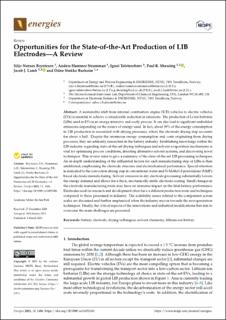| dc.contributor.author | Bryntesen, Silje Nornes | |
| dc.contributor.author | Strømman, Anders Hammer | |
| dc.contributor.author | Tolstorebrov, Ignat | |
| dc.contributor.author | Shearing, Paul Robert | |
| dc.contributor.author | Lamb, Jacob Joseph | |
| dc.contributor.author | Burheim, Odne Stokke | |
| dc.date.accessioned | 2021-03-08T09:59:06Z | |
| dc.date.available | 2021-03-08T09:59:06Z | |
| dc.date.created | 2021-02-24T13:45:07Z | |
| dc.date.issued | 2021 | |
| dc.identifier.citation | Energies. 2021, 14 (5), 1406-?. | en_US |
| dc.identifier.issn | 1996-1073 | |
| dc.identifier.uri | https://hdl.handle.net/11250/2732096 | |
| dc.description.abstract | A sustainable shift from internal combustion engine (ICE) vehicles to electric vehicles (EVs) is essential to achieve a considerable reduction in emissions. The production of Li-ion batteries (LIBs) used in EVs is an energy-intensive and costly process. It can also lead to significant embedded emissions depending on the source of energy used. In fact, about 39% of the energy consumption in LIB production is associated with drying processes, where the electrode drying step accounts for about a half. Despite the enormous energy consumption and costs originating from drying processes, they are seldomly researched in the battery industry. Establishing knowledge within the LIB industry regarding state-of-the-art drying techniques and solvent evaporation mechanisms is vital for optimising process conditions, detecting alternative solvent systems, and discovering novel techniques. This review aims to give a summary of the state-of-the-art LIB processing techniques. An in-depth understanding of the influential factors for each manufacturing step of LIBs is then established, emphasising the electrode structure and electrochemical performance. Special attention is dedicated to the convection drying step in conventional water and N-Methyl-2-pyrrolidone (NMP)-based electrode manufacturing. Solvent omission in dry electrode processing substantially lowers the energy demand and allows for a thick, mechanically stable electrode coating. Small changes in the electrode manufacturing route may have an immense impact on the final battery performance. Electrodes used for research and development often have a different production route and techniques compared to those processed in industry. The scalability issues related to the comparison across scales are discussed and further emphasised when the industry moves towards the next-generation techniques. Finally, the critical aspects of the innovations and industrial modifications that aim to overcome the main challenges are presented. | en_US |
| dc.language.iso | eng | en_US |
| dc.publisher | MDPI | en_US |
| dc.relation.uri | https://www.mdpi.com/1996-1073/14/5/1406 | |
| dc.rights | Navngivelse 4.0 Internasjonal | * |
| dc.rights.uri | http://creativecommons.org/licenses/by/4.0/deed.no | * |
| dc.title | Opportunities for the state-of-the-art production of LIB Electrodes – A review | en_US |
| dc.type | Peer reviewed | en_US |
| dc.type | Journal article | en_US |
| dc.description.version | publishedVersion | en_US |
| dc.source.pagenumber | 1406-? | en_US |
| dc.source.volume | 14 | en_US |
| dc.source.journal | Energies | en_US |
| dc.source.issue | 5 | en_US |
| dc.identifier.doi | https://doi.org/10.3390/en14051406 | |
| dc.identifier.cristin | 1893223 | |
| dc.description.localcode | © 2021 by the authors. Licensee MDPI, Basel, Switzerland. This article is an open access article distributed under the terms and conditions of the Creative Commons Attribution (CC BY) license (https:// creativecommons.org/licenses/by/ 4.0/). | en_US |
| cristin.ispublished | true | |
| cristin.fulltext | original | |
| cristin.qualitycode | 1 | |

